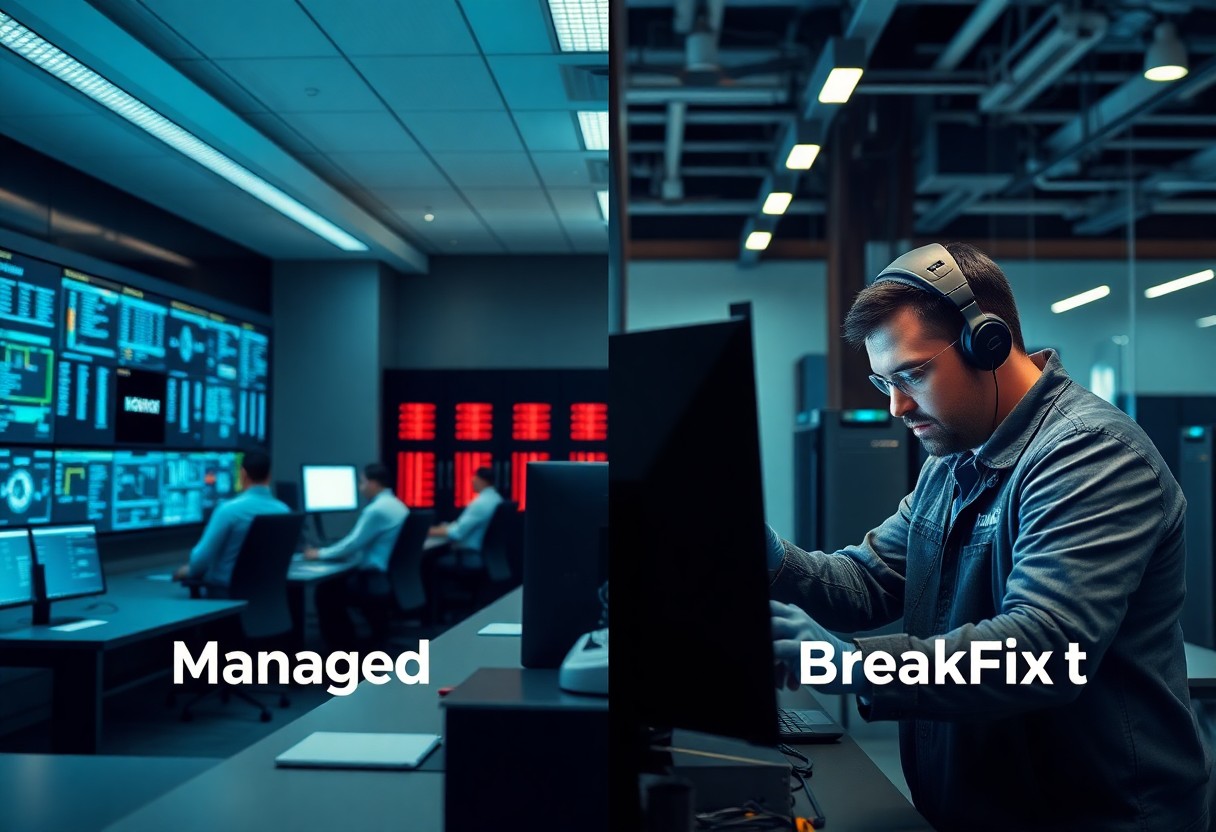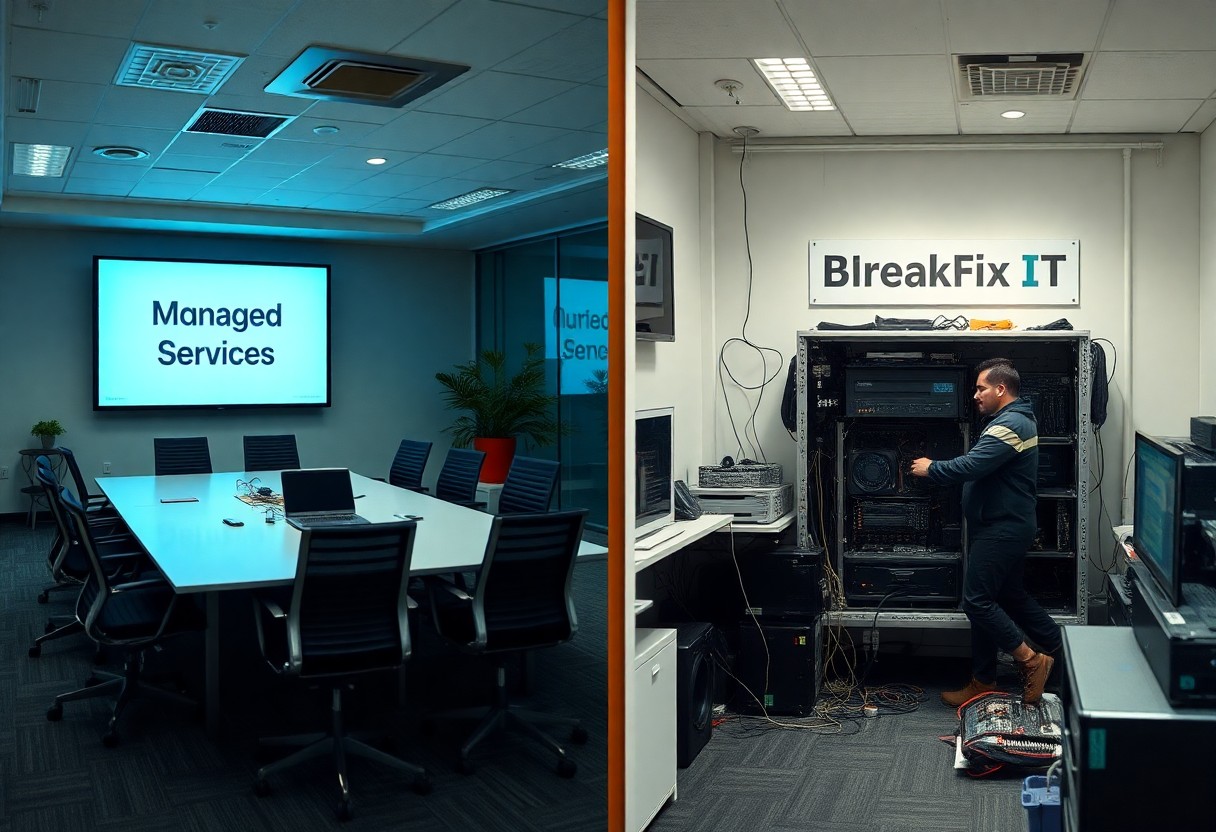What Is Endpoint Protection And Why It’s Critical For Cyber Security
You need to understand that endpoint protection is a vital component of your cyber security strategy. This technology...

Most businesses face a choice between managed services and BreakFix IT when it comes to their IT needs. With managed services, you enjoy proactive support and predictable costs, while BreakFix IT is often a reactive approach, addressing issues only as they arise. This can lead to unexpected downtime and increased expenses, making it imperative for you to understand how each model aligns with your organization’s goals and budget. By knowing these differences, you can effectively tailor your IT strategy for optimal performance and security.

Managed services refer to the proactive management of your IT infrastructure and end-user systems by a third-party provider. This model allows you to delegate specific IT responsibilities to experts, ensuring that your technology operates efficiently and securely while you focus on your core business activities.
In a managed services setup, your IT provider takes on the responsibility of monitoring, managing, and maintaining your systems. This includes a range of services such as network monitoring, data backup, cybersecurity, and support, all delivered under a subscription model, providing predictable costs.
The key components of managed services encompass network management, cybersecurity measures, backup and disaster recovery, cloud services, and technical support. Each component plays a vital role in maintaining your IT ecosystem to enhance productivity and minimize downtime.
Focusing on network management, your provider ensures optimal performance and security through continuous monitoring and maintenance. Cybersecurity measures involve implementing firewalls, antivirus solutions, and regular updates to defend against threats. Backup and disaster recovery processes safeguard your data from loss, while cloud services offer scalability and flexibility. Finally, dedicated technical support ensures any issues are swiftly addressed, keeping your business operations uninterrupted.
Break/Fix IT refers to a traditional model where businesses seek service only after an issue arises. Rather than maintaining proactive management, this approach entails reacting to equipment failures or software issues, incurring costs only when problems occur. You typically engage a technician to resolve the situation, paying for labor and parts required for repairs.
This model emphasizes transaction-based service, meaning you pay for repairs as needed rather than for ongoing maintenance. With Break/Fix IT, your technology needs are addressed only when they break down, which can lead to unpredictable costs and potential downtime. Such an approach leaves your systems vulnerable to larger issues.
Break/Fix IT is characterized by its reactive nature, straightforward billing per incident, and reliance on external technicians for repairs. You incur costs only after a breakdown occurs, often resulting in higher unexpected expenses. Additionally, you may face longer downtime during repairs, impacting productivity and efficiency.
This model often results in unpredictability; each repair can vary significantly in cost and time. You might find yourself managing multiple invoices, complicating budgeting and financial planning. Furthermore, this reactive approach may lead to escalating issues, as small problems can escalate if left unaddressed until they fail. In contrast, proactive measures in managed services might mitigate these risks, offering a more stable budgeting path and improving overall system reliability.

Evaluating the financial implications of managed services versus Break/Fix IT sheds light on their operational effectiveness. While The 6 Biggest Differences Between Break-Fix vs. Managed … highlight various aspects, cost remains a pivotal factor. Managed services typically involve a predictable monthly fee, allowing for budget forecasting, whereas Break/Fix can incur unpredictable costs based on emergency repairs.
Cost Analysis Table
| Managed Services | Break/Fix IT |
|---|---|
| Predictable monthly costs | Unpredictable repair costs |
| Budget forecasting | Budget inconsistency |
| Includes proactive maintenance | Reactive only |
Managed services present a stable financial model, often offering services through a subscription model that covers maintenance, monitoring, and support. This approach mitigates the risk of unforeseen expenses, allowing you to allocate your IT budget more effectively. Typically, businesses can expect monthly fees that range from a few hundred to several thousand dollars depending on the complexity of services required.
Break/Fix IT relies on a pay-as-you-go structure, resulting in potential volatility in your expenses. Every failure or IT issue triggers significant repair costs that can quickly accumulate. Routine maintenance is often overlooked, leading to more frequent and costly breakdowns, which can be substantially higher than the predictable costs associated with managed services.
This unpredictable model can strain your budget, especially if multiple crises arise within a short period. For instance, a server failure which requires immediate attention may set you back by thousands in repair costs, not to mention lost productivity during downtime. Therefore, while initially enticing due to low upfront costs, Break/Fix IT can lead to greater expenses over time if not managed carefully.
SLAs are fundamental in defining the framework for your IT service engagement, differentiating managed services from break/fix scenarios. While managed service providers offer clear SLAs that outline performance metrics, response times, and accountability, break/fix models typically lack such structured agreements. Understanding SLAs helps you achieve operational efficiency, and you can explore how to smoothly Transition from Break-Fix to Managed Service Provider.
In managed services, SLAs establish a mutual understanding of expected service quality and performance. These agreements may include specific metrics like uptime guarantees, response times, and resolution times, allowing you to hold your provider accountable. A well-crafted SLA facilitates transparency, ensuring that service providers are aligned with your business objectives and operational requirements.
Break/fix models often operate without formal SLAs, leading to unpredictable service delivery. The absence of clear agreements means providers may prioritize urgent issues without guaranteeing timely resolutions for ongoing problems. The lack of commitment can leave you vulnerable to costly downtime, affecting productivity and operational costs.
This unpredictability in break/fix models can significantly impact your business. For example, if an unexpected hardware failure occurs, you might face long waiting times for a technician to arrive, resulting in extended operational disruptions. In contrast, a managed service approach with defined SLAs ensures that you receive prompt service, aligning recovery times with your business needs and ultimately reducing the risk of potential revenue losses. Without proper SLAs, you may find yourself navigating IT challenges with little assurance of timeliness or effectiveness in resolving issues.
Understanding the distinction between proactive and reactive support is vital for choosing the right IT service model. Managed services focus on preventing issues before they arise through consistent monitoring and maintenance, while Break/Fix IT waits for problems to occur, addressing them only after they impair operations.
Managed services employ a proactive approach by continuously monitoring your systems and applications. This includes regular updates, security checks, and performance assessments, ensuring vulnerabilities are addressed before they escalate into major problems that could disrupt your business.
Break/Fix IT is inherently reactive, responding only after a problem has been identified. This method often leads to extended downtime, unexpected costs, and a chaotic environment, as your IT infrastructure is only serviced when issues arise, rather than being continuously optimized.
This reliance on a reactive nature can create an unstable IT landscape. For example, if a critical server goes down, the time spent diagnosing and fixing the issue can lead to significant operational losses. Statistics show that companies can lose up to $5,600 per minute due to downtime, illustrating how a Break/Fix model can be financially detrimental. By halting preventative measures, businesses risk falling behind in technology advancements and exposing themselves to security vulnerabilities. The lack of foresight and planning often results in missed opportunities for efficiency and innovation.

Assessing the right IT support model hinges on your unique business needs and objectives. Consider factors like budget, growth potential, and desired responsiveness. Explore The Difference Between BreakFix and Managed IT Support to gain deeper insights into how each approach aligns with your operational goals.
Choosing between managed services and break/fix IT requires a nuanced understanding. Among the key considerations:
After weighing these factors, you’ll be better equipped to select the most suitable option for your organization.
Your choice between managed services and break/fix IT has significant long-term implications for business operations. A break/fix approach may lead to increased downtime and unanticipated expenses during critical moments, undermining productivity and user satisfaction. On the other hand, managed services provide proactive support, ensuring your systems remain operational, secure, and optimized for efficiency. This predictability fosters a stable environment conducive to growth, allowing for seamless scaling and innovation.
Considering all points, understanding the difference between managed services and break-fix IT is vital for optimizing your business’s technology strategy. Managed services offer proactive support and consistent maintenance, allowing you to focus on your core operations, while break-fix relies on reactive solutions, often leading to unexpected downtime and costs. By choosing the right approach, you can enhance your operational efficiency and ensure that your IT infrastructure meets your evolving needs.
A: Managed Services involve ongoing support and management of IT systems by a third-party provider. This includes proactive monitoring, regular maintenance, and system updates, ensuring optimal performance and reliability of IT infrastructure.
A: Break-Fix IT refers to a reactive approach where IT support is provided only when issues arise. This model focuses on resolving problems after they occur, often resulting in downtime and potential loss of productivity.
A: The main differences include the proactive nature of Managed Services versus the reactive approach of Break-Fix IT. Managed Services typically involve a subscription fee for continuous support, while Break-Fix requires payment for services only when issues happen. Managed Services aim to prevent problems, whereas Break-Fix deals with issues post-occurrence.
You need to understand that endpoint protection is a vital component of your cyber security strategy. This technology...
You rely on robust cybersecurity measures to protect your business from evolving threats, and Endpoint Detection and...